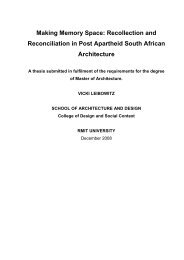Objects in Flux - RMIT Research Repository - RMIT University
Objects in Flux - RMIT Research Repository - RMIT University
Objects in Flux - RMIT Research Repository - RMIT University
You also want an ePaper? Increase the reach of your titles
YUMPU automatically turns print PDFs into web optimized ePapers that Google loves.
<strong>Objects</strong> <strong>in</strong> <strong>Flux</strong><br />
10/ In <strong>in</strong>terpret<strong>in</strong>g practices of ob-<br />
ject modification through a ‘field of<br />
relations’ care must be taken not to<br />
position the <strong>in</strong>dividual as dist<strong>in</strong>ct from<br />
the field. The modifier does not simply<br />
trace a path with<strong>in</strong> a field (as a figure<br />
walks a ground). Rather the <strong>in</strong>dividual<br />
constitutes (and is constituted by) the<br />
field; the path of modification arises<br />
from the field of relations rather than<br />
be<strong>in</strong>g <strong>in</strong>scribed <strong>in</strong> it from ‘outside’.<br />
The modification process is both a<br />
function of the field and a transforma-<br />
tion of it.<br />
46<br />
project, we can beg<strong>in</strong> by acknowledg<strong>in</strong>g the various conditions that<br />
contributed to its remak<strong>in</strong>g as a parabolic microphone. These <strong>in</strong>clude:<br />
• a discrete number of components and fitt<strong>in</strong>gs<br />
• a language of use that <strong>in</strong>cludes reflection, direction and spatial<br />
position<strong>in</strong>g<br />
• cultural value established through historic narrative<br />
• personal familiarity and appreciation.<br />
These conditions both assist and limit the act of modification. The<br />
exist<strong>in</strong>g lamp components provided opportunities for the mount<strong>in</strong>g<br />
of new hardware (specifically, locat<strong>in</strong>g the volume control and<br />
headphone jack) and the lamp’s language of use effectively supported<br />
its new role as parabolic microphone. In contrast, the lamp’s cultural<br />
value, coupled with my own personal appreciation for the lamp,<br />
served to block any significant alterations to the lamp’s physical form.<br />
The above conditions may be abstracted <strong>in</strong>to the follow<strong>in</strong>g general<br />
categories:<br />
• material constra<strong>in</strong>ts and affordances<br />
• language of use<br />
• cultural narrative<br />
• personal history.<br />
Taken together, these categories beg<strong>in</strong> to def<strong>in</strong>e a field of relations<br />
specific to practices of object modification. As with the lamp modification,<br />
the features of this field may be rendered as either obstacles<br />
to be circumvented or, alternatively, opportunities that offer passage<br />
through the field. The specific topology of this field – the collection<br />
of obstacles and passages – will <strong>in</strong>form the various paths the modification<br />
process may take. 10 The emergent quality of this path suggests<br />
a process-orientated practice determ<strong>in</strong>ed through engagement with<strong>in</strong><br />
a field rather than the deployment of a strategy or plan. This is not<br />
to say that practices of object modification do not pursue goals, but<br />
rather that these goals are negotiated through the act of mak<strong>in</strong>g. If<br />
this claim is true then the products of these practices – the stories,<br />
material artefacts, and the participants themselves – should present<br />
evidence of this negotiated, transformative journey; we may expect<br />
to f<strong>in</strong>d an adaptive, opportunistic practice that exhibits themes of<br />
exploration and <strong>in</strong>vention.
















